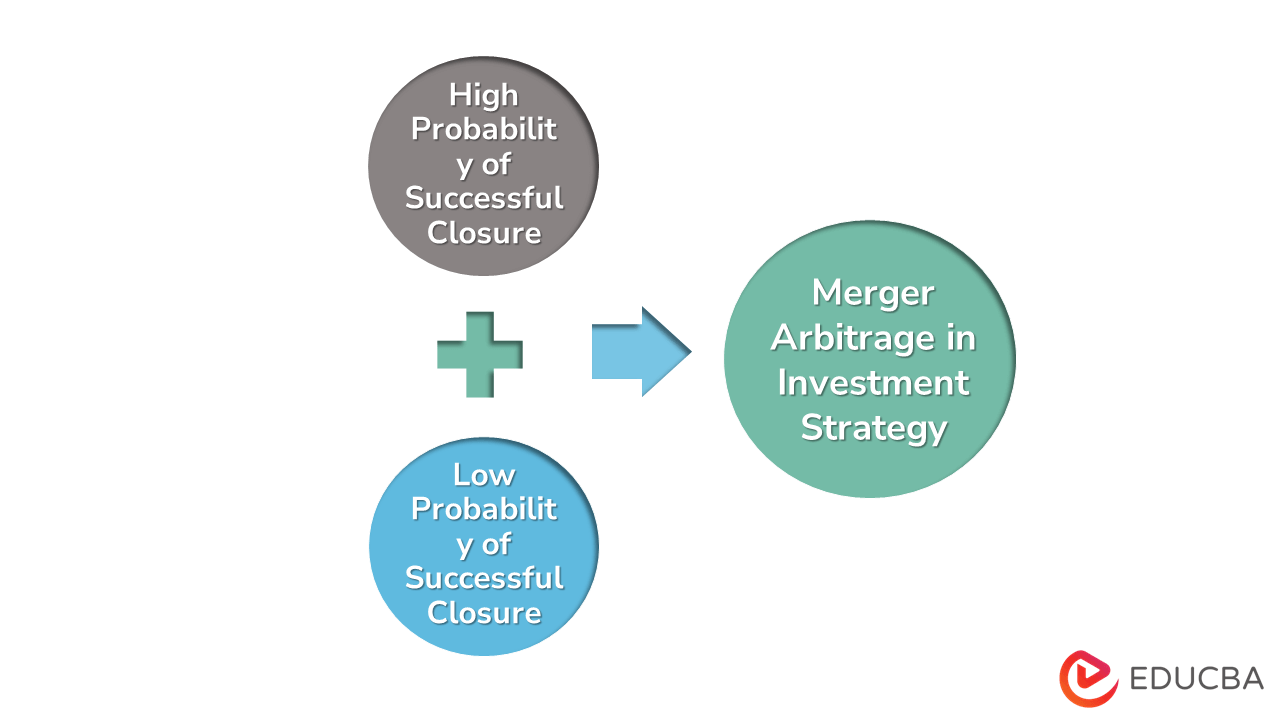
What is Merger Arbitrage
The term “merger arbitrage” refers to the investment strategy that involves simultaneous buying and shorting of stocks of two merging entities to construct a financial instrument that offers “riskless” profit.
In other words, merger arbitrage is an investment strategy in which an investor takes advantage of the market inefficiencies regarding the occurrence of a merger or acquisition and the uncertainties of the probable outcomes. It is an event-driven strategy usually deployed by hedge funds, and it is also popularly known as Risk Arbitrage.
How Does Merger Arbitrage Work?
As has already been discussed above, investors use merger arbitrage to exploit the uncertainties surrounding the successful execution of a merger, especially during the period between the announcement of the acquisition and the formal completion of the same. For instance, let us assume that Company A is the acquirer, and Company B is the target in a merger transaction. On Jan 1, 2020, Company A announced that it would acquire Company B in the next six months at the offered price of $100 per share. On the announcement day, Company B’s share price jumped from a pre-announcement price of $70 to close at $85 per share.
The period between the announcement of the deal and its formal execution is critical for a merger arbitrage, which in this example is six months. This period includes many processes, such as shareholders’ approval for the deal, approval from the regulatory authorities, tracking of the target company’s performance, and a bunch of legal paperwork. The spread between $85 and $100 captures the perceived risk of the deal not going through as per plan. Now, as the day for the deal arrives, and if there is no negative news about the merger, the target company’s share price will continue to inch toward the target price of $100.
On successful completion of the deal, the investor who invested at $85 per share will make a profit of 17.6% (= ($100 – $85) / $85 * 100%), which can be annualized to 35.2%. The investor who bought the target company’s share on the announcement date and waited for the deal to execute could achieve an annualized return of 35.2%.
Examples of Merger Arbitrage
Some of the significant examples have been discussed below:
- In June 2016, Microsoft Corp. announced that it would acquire LinkedIn Corporation as per a definitive agreement. It was an all-cash transaction worth $26.2 billion, under which Microsoft bought each LinkedIn share for $196. On the announcement day (June 13, 2016), LinkedIn stocks started trading at $131.08 per share to close at $192.21. The deal was completed in December 2016. If an investor had bought a LinkedIn share at $192.21 and waited for seven months, he would have made an annualized profit of 3.38% (= ($196 – $192.21) / $192.21 * 12 / 7). It is an example of merger arbitrage.
- In October 2018, IBM and Red Hat entered into a definitive agreement under which IBM agreed to purchase the entire equity share of Red Hat at a target price of $190 per share in an all-cash merger. The transaction was one of the most significant tech acquisitions of the year, valued at approximately $34 billion. The pre-announcement price of $116.87 per share soared up to $$169.93 by the end of the announcement day. The deal was completed in July 2019. If an investor had bought Red Hat’s share at $169.93 and waited for eight months, he would have made an annualized profit of 17.7% (= ($190 – $169.93) / $169.93 * 12 / 8). It is another example of merger arbitrage.
Merger Arbitrage in Investment Strategy
As an investor interested in taking advantage of a merger, one must evaluate the probability of whether or not the merger will be executed successfully.
Now, a merger arbitrageur has a strategy for both situations.
- High Probability of Successful Closure: A merger arbitrageur will purchase the shares of the target company (trading at a lower price band) while shorting the acquiring company’s shares (trading at a higher price band). Now, after the successful closure of the deal, the target company’s share converts into the acquiring company’s shares. In this case, the investor will use the converted shares to cover its short position and, as a result, will sell the shares at a higher price.
- Low Probability of Successful Closure: In this case, the investor will short-sell the target company’s stocks. When the merger fails, the target company’s share price will fall back to the pre-announcement level. The failure of the deal can be due to multiple reasons. However, the arbitrageur can profit by purchasing the company’s stocks at a lower price and covering its short position.
Advantages and Disadvantages
Advantages
Merger arbitrage has several advantages, and some of them are as follows:
- In most cases, merger arbitrage strategies focus on limiting downside risk and making informed decisions. As a result, these strategies are market neutral and can profit in any market situation.
- These aggressive strategies can yield a high return in a brief period if appropriately executed.
Disadvantages
Merger arbitrage has several disadvantages, and some of them are as follows:
- At times, some investors use these strategies speculatively, which may surge the stock prices to levels that cannot be explained through fundamental analysis.
- More considerable hedge funds deploy bulk transactions and use these strategies to influence the market.
Recommended Articles
This is a guide to Merger Arbitrage. Here we also discuss the introduction and how merger arbitrage work with different examples. You may also have a look at the following articles to learn more –


